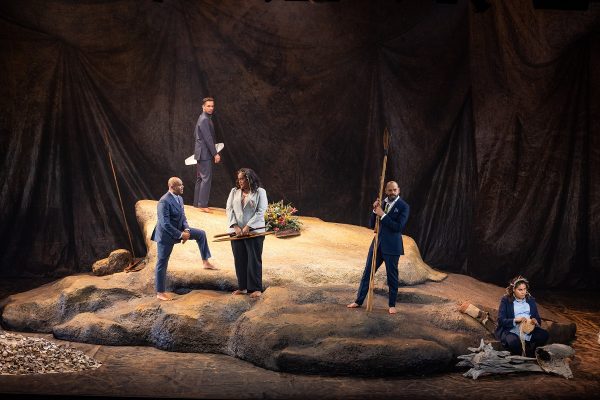
Theatre / “The Visitors”, by Jane Harrison. At The Playhouse until November 11. Reviewed by ARNE FEALING.
HAVE you ever walked through an art gallery in Australia and seen the portraits of First Nations’ people, dressed in European clothes, or standing still on a cliff – observing a foreign-looking boat in a harbour?
Consider everything you know about politics, European history and Australia’s First Nations’ people; war, settlement, diplomacy and nature. And replace that set of costumes and history with that of our First Nations people, as depicted by the striking and familiar artwork hung in galleries across Australia.
Liberally using indigenous dialect to beautiful effect, a technique of mixing the artistic and political language of indigenous and western culture together made a clever, powerful point: we share a common language.
It’s a tale as old as time.
It could be possible to have this play spoken entirely in an indigenous dialect. Sending a message that language and visual symbolism reaches above and beyond politics and culture.
“The Visitors” opened with an elders’ meeting discussing the arrival of a new boat from lands elsewhere. Aside from painting a culturally cleansing and often comedic picture of people debating if they welcome these visitors in peace or go to war – this made sure the audience could do nothing but see culture and politics as shared, despite our potentially disparate traditions.
Ironically, it was the same contest for English people after Vikings first travelled to raid and try to farm warmer landscapes.
The creative team here has deliberately decided to take images from our cultural representations of indigenous Australians in painting and photographs. The cultural integration symbolises Australia today – but transposes it to be owned by our original inhabitants: a mix of tradition, history – and the common sense that we can find common ground through reconciliation. A powerful lesson. Depicted through the arguments and discussions of the elders’ meeting this play presents.
The acting and production craft in this show was generally stunning. A few dropped lines here and there despoiling its polish – the cast delivered the presentation with gravitas. Representing symbolic roles, the young warrior wanting to be heard, the war chief, a wise aunty hoping for a diplomatic peace and shared sense of optimistic care, and a wise bushman who existed outside of anything but the moment in time, slowly considering the wealth of this country he would hope to share. They deliver a message of understanding, old history and fights already fought, for future conflict to be re-represented in an attitude of peace.
Human conflict wrapped up in a nutshell. Certainly, at least for the period that was about to ensure.
The evening ended with a call for peace in Gaza, likening it to what the First Nations people suffered through here. And of course, the similarities are obvious. The solutions – probably a whole lot harder to understand. Even now.
Who can be trusted?
In a world of spin and confusion, there’s never been a more important time to support independent journalism in Canberra.
If you trust our work online and want to enforce the power of independent voices, I invite you to make a small contribution.
Every dollar of support is invested back into our journalism to help keep citynews.com.au strong and free.
Thank you,
Ian Meikle, editor



![For graphic designer Tracy Hall, street art is like any artwork, her canvas has been swapped out for fences and plywood, her medium changing from watercolours to spray paint.
A Canberra resident for 13 years, Tracy has been a street and mural artist for the past five.
Her first exploration into grand-scale painting was at the Point Hut toilets in Banks five years ago. “They had just finished doing up the playground area for all the little kids and the words [of graffiti] that were coming up weren’t family friendly,” she says.
“So I ended up drawing this design and I got approval for the artwork.”
Many of Tracy’s time-consuming artworks are free, with thousands of her own dollars put into paint.
@traceofcolourdesigns
To read all about Tracy's fabulous street art, visit our website at citynews.com.au or tap the link in our bio! 🎨🖌
#canberranews #citynews #localstories #canberrastories #Citynews #localnews #canberra #incrediblewomen #journalism #canberracitynews #storiesthatmatter #canberralocals #artist #streetart #streetartist #StreetArtMagic](https://scontent.cdninstagram.com/v/t39.30808-6/490887207_1225841146218103_6160376948971514278_n.jpg?stp=dst-jpg_e35_tt6&_nc_cat=106&ccb=1-7&_nc_sid=18de74&_nc_ohc=MUiEmedc4VAQ7kNvwHTUMX_&_nc_oc=Adk-5HjcsfQwB-n_l8zetmr0YqMaupGjrl2gNVCZdsmkxwn-oqjBg_V7pLtGggCE43s&_nc_zt=23&_nc_ht=scontent.cdninstagram.com&edm=ANo9K5cEAAAA&_nc_gid=ArypbXJrhJlgkEK_eVch4g&oh=00_AfG8ftIXR22MgCATlN0LVjY-fBO4qR2nx6yZcRB9-XzjrQ&oe=6808E914)




Leave a Reply